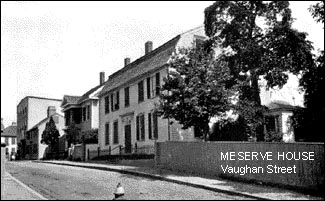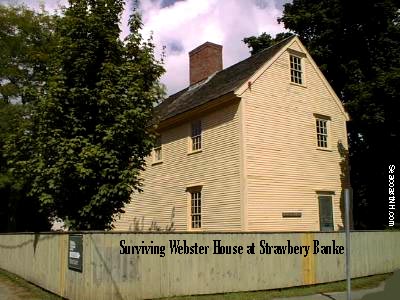| Daniel Webster Lost in Portsmouth |
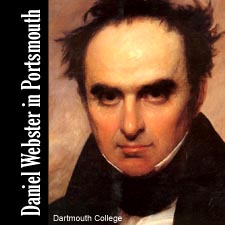
UNKNOWN NH HISTORY
New Hampshire's best known orator cut his teeth as a lawyer here in Portsmouth, NH. He lived in four houses, got married, kep an office and began his family. But times were tough and fame called him to Massachusetts. Here is the story of how Daniel Webster lived a decade in the state's only seaport, but has been all but forgotten inthe town he once loved.
READ ABOUT Daniel Webster's Farm
Fresh from Phillips Exeter Academy and Dartmouth College, the hick young lawyer from Salisbury, NH arrived in Portsmouth at the peak of its prosperity in 1807. New Hampshire's only seaport was a wealthy bustling town, already nearly 200 years old. The Revolutionary War was no more distant to residents than Viet Nam is to us today. Downtown Portsmouth, with its elegant mansions and 5,000 residents was the ideal spot to open a law office. In his autobiography, America's most famous orator would later recall his nine years here as among the happiest in his life.
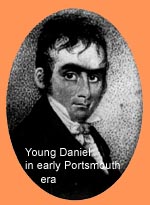 Webster lived at four locations in the city and set up his law practice just off Market Square. Only 26 when he arrived, Webster was already feeling like an old bachelor and within a year he had purchased a house and married Grace Fletcher of Hopkington. They had two children during their Portsmouth years.
Webster lived at four locations in the city and set up his law practice just off Market Square. Only 26 when he arrived, Webster was already feeling like an old bachelor and within a year he had purchased a house and married Grace Fletcher of Hopkington. They had two children during their Portsmouth years.
Though his law practice was an immediate success, the Websters, not aggressively social, preferred evenings at home. That may be, some have suggested, because the young Webster was at times haughty, grim and full of himself. It may also be because attorney Webster was rarely at home. Practicing law on the "circuit" court in the early 19th century literally meant following the judge from one rural NH town to the next. Webster was often gone for weeks in all seasons, living at inns and country houses, sharing a room with the attorneys he would face in court the next morning.
On the road, without law books and with only hours to prepare his cases, Webster evolved his dramatic courtroom style. He learned his technique, he said, from renowned Seacoast lawyers. Jeremiah Mason of Portsmouth, a large and threatening man, became his primary sparring partner in the traveling courts and a close friend. Lawyer George Sullivan of Exeter, son of the Revolutionary war hero Gen. Sullivan of Durham, taught Webster grace and a more elegant demeanor.
From NH Supreme Court Judge Jeremiah Smith, Webster learned that even lawyers could be tolerant, friendly and courteous. Most Webster biographers, including Webster himself, agree that he left Portsmouth a much kinder, wiser and seasoned man than when he arrived. He learned to rely on his natural skills and instincts, rather than raw case law and pompous orations. Webster also said he never again found wiser men and better friends than those he met at the NH Bar. Years later, while speaking to former Portsmouth colleagues, this memory brought tears to his eyes.
Tracking the Webster Landmarks
Daniel Webster is Portsmouth's most famous long-term resident. John Paul Jones stayed just 18 months, George Washington visited four days, and Paul Revere barely spent the night. But despite nine years (actually eight years and 11 months) in town, Webster's presence has all but faded from view. One house remains of the four in which he lived, and that one is not currently open to the public. So, while many of the downtown mansions Webster knew well have survived, his presence has faded.
Although he moved from Portsmouth in 1817 to become a life-long resident of Massachusetts, Webster remains identified with the Granite State. His statue stands directly in front of the State House in Concord. The replica of his birthplace in Franklin is a popular tourist site. There is a Daniel Webster Highway in Manchester, a Daniel Webster College. He is a revered alumus of Phillips Exeter Academy, and at Dartmouth College where he fought one of his most famous cases. In the 1937 short story "The Devil and Daniel Webster" (made into a movie in 1941) author Stephen Vincent Benet has Webster's character exclaiming, "I'd fight 10,000 devils to save a New Hampshire man."
So where are the monuments in Portsmouth? A front-page article in the Portsmouth Herald from 1958 sheds a little light: "In 1932 the committee in charge of commemorating Webster's 150th anniversary came to Portsmouth to put plaques on the houses, but both [Vaughan and High streets] were in such miserable shape that they threw up their hands in horror and gave up the idea entirely...it was decided that since nobody particularly cared, it was better to forget that they ever existed."
Tracking Webster's life here says a lot about the town itself, about its rush to the future and its connections to the past, about business versus history and neighborhoods versus progress.
Continue with 4 PORTSMOUTH HOMES
Four Portsmouth, NH Homes
Bachelor Quarters (circa 1807)
Arriving in 1807, Webster stayed in a men's rooming house which is described as "near the Buckminster House". This ornate, beautiful three-story home was one of the city's oldest and finest. Located at #1 Islington Street, across from what is today the Portsmouth Public Library, this 1720 mansion was torn down in the mid-twentieth century and is today a parking lot. Webster may have lived a few doors further down the street.
Vaughan Street (circa 1808)
Long before urban renewal tore up chunks of historic Portsmouth, Vaughan Street was the place to be. Revolution Era visitors like George Washington attended fashionable parties at the Assembly House there. From the center of town, the street stretched to a residential area where Daniel Webster and his new wife first set up housekeeping at the "Meserve" house built in 1760. Attorney Jeremiah Mason had just moved from here to his new large home in town and probably brokered the deal. The house reportedly had a distinctive garden. The house appears in a number of early guides, but by 1958 had become an unattractive storefront. It and the entire North End neighborhood was bulldozed soon after. Today Webster's second house has been replaced by the parking lot of the Portsmouth Parade Mall.
Pleasant Street (circa 1808-13)
Within two years of his arrival in town, Webster's successful law practice was bringing in $2,000 a year, four times his earlier small town income. The young attorney and his new wife purchased their first house near the corner of Pleasant and Court streets, just a stone's throw from the mansion of Governor John Langdon who had once entertained President George Washington. An 1884 Portsmouth guidebook says Webster's house was near the "Jenness house."
The house burned in 1813 during one of the many devastating fires that, combined with an embargo and the War of 1812, hit the local economy and spirit hard. The "Great Fire" burned 272 buildings. Webster was away at Congress in Washington, DC and his family (their second child was born in 1813) was visiting neighbors at the time of the fire. The uninsured house had cost $6,000 and Webster's law library too was lost. He noted in a letter that he also regretted the loss of the first skin of wine he had ever owned.
Financially wounded by the fire that had wiped out their previous home, the Webster's moved to a more modest house on High Street near where the city parking garage now stands. The house was built in 1785 with one gable end and one hip roof end. Small compared to the homes of his contemporaries, the four-room house was at the time attached to another wing which may have included a larger kitchen. With his own home taken by fire and his status in Washington, DC growing, it seems likely Webster was already planning his move to Massachusetts by this time. He may have stayed in this house only a short time. Immediately after the fire, Webster continued on in Washington while his family wintered with friends in Portsmouth, perhaps in the home of lawyer Jeremiah Mason.
The city's only surviving Webster home is mentioned in an 1884 guidebook and appears on early post cards. At the beginning of the 20th century, the house appears on city maps as either #58 or #60 High Street in "Webster Court." From 1937 to 1943 it appears in local phone books as a lodging called the "Webster House." In 1961 the house was saved from urban renewal and moved from the North End to the outskirts of the new Strawbery Banke Museum. Today it can be seen on Hancock Street in the South End. Owned by Strawbery Banke, the Webster House is currently rented to tenants and not open to the public.
Market Street Office (circa 1607-1616)
Webster maintained a small two room office within view of Market Square in downtown Portsmouth during his entire time here. His second floor site on the west side of the road was likely at #18 or #20 Market Street. The office was at the top of a steep set of stairs over a store, now a restaurant. It was described as a very ordinary space with "less furniture and more books than common." Over the years it has had many tenants, a sporting goods store, a print office, possibly a camera store and a used clothing boutique and private condo. No plaque marks the spot.
The Old North Church
There is one simple painted plaque in Market Square that mentions Daniel Webster. It says he was a warden at the Old North Church, today the most recognizable symbol of Portsmouth with a lighted white spire that defines the city skyline. Unfortunately, this is not the church building that Webster attended. The church he knew was redesigned in 1837 and then completely rebuilt in 1855.
Back from the dead, Daniel Webster would recognize the city’s many colonial homes, but Portsmouth, for the most part, no longer recognizes him.
Copyright © 2006 by J. Dennis Robinson. Dennis Robinson’s essay on the Whitier House in Amesbury appears in the latest edition of Accent Home and Garden. He is editor of the region web site SeacoastNH.com.
Continue with 4 PORTSMOUTH HOMES
More Daniel Webster House Pix
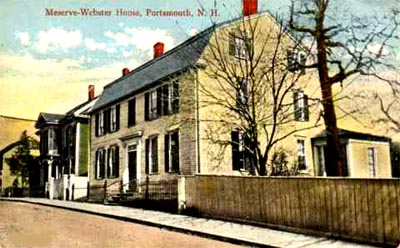
Daniel Webster House (built 1760)
137 Vaughan Street, Portsmouth, NH
This street and everything on it was replaced by the Portsmouth Parade Mall off Hanover Street in the 1960s. The supermarket there is now office buildings. A piece of the road still exists as the Vaughan Mall. Webster lived here right after his marriage in 1808 and knew it as the Meserve House. George Meserve had been appointed by the British to collect Portsmouth taxes just as the dreaded Stamp Act was enacted in 1765. Meserve's Portsmouth neighbors burned him in effigy and forced him to resign the position, which he quickly did. At the turn of the 20th century as the immigrant North End evolved, the house was converted into two stores (see 1958 picture below from the Portsmouth Herald) and was later flattened along with the rest of the neighborhood during urban renewal.
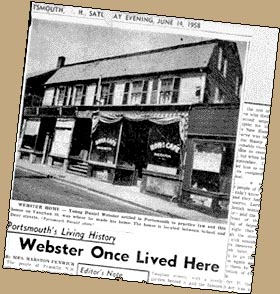
Continue with 4 PORTSMOUTH HOMES
More Daniel Webster House Pix
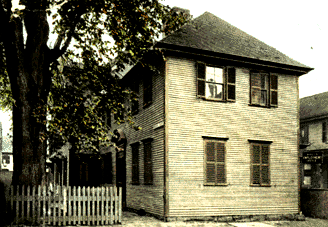
Daniel Webster House (built 1785)
High Street, Portsmouth, NH
This early postcard shows the High Street house before it was moved to Strawbery Banke. The cards says Webster lived there from 1813-1817 though the dates show wishful thinking. Webster was in Washington until April 1814 and was on his way to Cambridge by August 1816. The illustration below shows how the house was once attached (left side) to another wing, thus explaining the single hip roof design which looks odd when seen today without the attachment. The house is now on Hancock Street and currently rented to tenants.
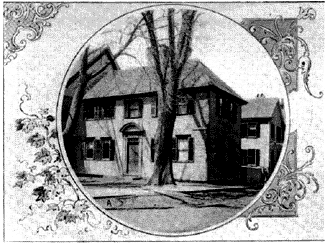
Copyright (c) 2006/ SeacoastNH.com . First posted on this site in 1997.

